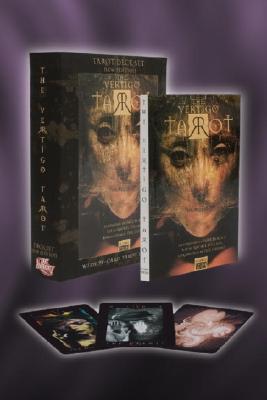
by Rachel Pollack and Dave McKean with Foreword by Neil Gaiman
5 Stars for artwork & Vertigo interpretations
5 Stars for companion book, both in terms of content and publication/binding quality
5 Stars for packaging, box & card holding tray
3 Stars for card stock quality
*Gorgeous, eerie addition to a Sandman or DC Vertigo collection
*In-depth, intense addition to a tarot collection
*Best matched to an advanced or experienced reader — card interpretations often diverge or take a circuitous path from the traditional RWS card interpretations; this might confuse a novice reader
Anything that brings together Rachel Pollack, Neil Gaiman, and Dave McKean can’t go wrong, and this deck showcases that. The forward by Gaiman is everything you’d expect and want to read, affirming the idea that creativity and the occult are symbiotic entities that bring forth new ideas, new narratives, and new perspectives.
The book is one of the most unique guidebooks I’ve ever read, on par with the David Bowie Starman deck. In fact, these two decks have a very similar energy — if you get along with one of these decks, you are likely to resonate with the other.
Card explanations use both language and unconventional typography to signify meaning, and because of this, if you are new to reading or have not ventured outside of traditional RWS card meanings, this may be a little bit jarring at first, but it truly teaches the reader to explore shadow meaning as a primary card interpretation, not only looking at shadow meanings as part of a card reversal meaning. Though this may be a little intense for a new reader, for the new reader who is called to the cards, this will be like finding a puzzle piece that completes the big picture. I remember clearly as a high schooler my first best friend who read cards using this deck and to this day, they use this deck — so don’t let the cautionary note be discouraging.
If you are called to this deck, listen.
The art of Dave McKean is a challenging choice for a tarot deck because it requires the reader to employ a certain measure of patience, because meaning and symbol do not lay themselves out for the taking, it is more of a gradual unfurling or unwrapping of meaning as you truly look at what’s on the card. Your brain can’t take a lot of “short cuts” with readings from this deck, and that can be a good thing.
Most of the cards of the Major Arcana are assigned an astrological attribution, with only a few exceptions. Likewise, a series of 4 of the Major Arcana are not assigned a Vertigo figure (The Sun, The Moon, The Star, Judgement). While I appreciate that the deck didn’t “force” a character to represent cards to make it complete, please note the minor arcana do not correspond with specific Vertigo characters, I do think that there are characters who could have easily been matched to these attributions and to me, that seems like a missed opportunity, especially since none of the minor arcana are directly related to Vertigo characters or scenes. The guidebook refers to this series of cards as “deep process” cards, which works, but I would have loved to see a few additional Vertigo characters represented (like Kid Eternity, who could have been a really interesting choice for Judgement, or The Moon.)
Note that this is a DC Vertigo tarot, not a specifically Sandman tarot deck. Though represented more than other comics in the Vertigo line, Sandman and Sandman-offshoot cards only represent a few cards. The lines are a cross-section of the 90s heyday of Vertigo. Bear in mind that in the Vertigo tarot, there are only 18 major arcana cards that correlate to a specific Vertigo character.
Lines represented: Hellblazer, Books of Magic, Death: The High Cost of Living, The Geek ( a personal favorite!), The Sandman (Morpheus is The Hierophant), The Enigma, Black Orchid, The Phantom Stranger, Sandman Mystery Theater, Shade, The Changing Man (another personal favorite), Doom Patrol, and Swamp Thing.
Minor arcana cards don’t refer back to any specific Vertigo characters or lines — however, because McKean’s artwork is virtually synonymous with Vertigo because he created so many of the ubiquitous covers, his work is de facto its own “Vertigo line.” For some readers, this is not an issue, but for someone looking for a very specific Sandman or DC Vertigo deck, this might be a deal breaker.
The minor arcana cards, like the major, take traditional RWS images and tropes and distort them, the same way that McKean’s art is recognizable as what it IS, but also is assuredly NOT the thing as you traditionally recognize it. The minor cards are more abstract than the majors, and all the cards rely on abstractions to put the reader fully in control of the reading — or to allow their subconscious to drive the reading.
This isn’t a deck for everyone, and it’s not really a “casual reading” deck. It’s only been printed twice, once in 1995 and once again for the 20th anniversary, and both runs were limited. It’s tough to track down and pricey if you can find it, so be sure it’s one you want to add to your collection.
Last note bears mentioning, especially for advanced readers: the card stock (on BOTH pressings — HOW???) is really not very good. The card stock is more like novelty card stock, which is truly a shame because it does a disservice to McKean’s art and the fact that the guidebook is written by Rachel Pollack. The cards are thin, overly glossy, and the edges really show the cutter punch marks. If you truly wanted to, you could probably edge the cards, but that would also likely devalue them, so again — that’s a “your call” decision. However, due to the rarity and accompanying price point of this deck, it really needs to be mentioned.